The Netherlands is globally recognized as a country with an innovative agricultural sector and extensive expertise in breeding, cultivation, etc. Recently, a proud Minister Piet Adema mentioned that interested parties from around the world approached him at the Grüne Woche to hear what the Netherlands has to offer. The country is a leader in, especially, the areas of breeding and seed potatoes, but it also has a wealth of knowledge regarding crop cultivation. The know-how (infrastructure) and experience accumulated over the years and the presence of seaports play a role, too.
Despite being third in the global trade of agricultural products, the Netherlands holds a modest 5.4% share. And it has a tiny share in the worldwide production of those products. A very rough estimate puts that at 0.4%. The EU27 has a share of about seven percent of global agricultural production.
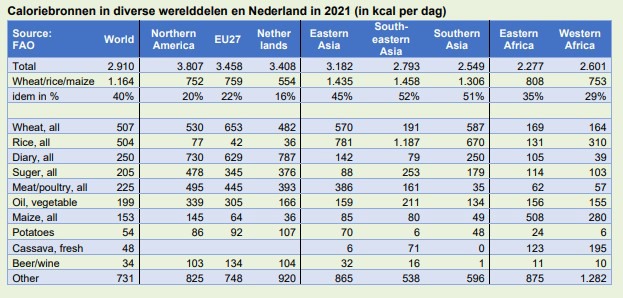
Wheat, rice, and corn make up 49% of global calorie intake
Before delving deeper into the Netherlands' global trade position, it is vital to understand which products are significant in the world's population's ultimate nutrition. There are significant differences. Globally, three products - wheat, rice, and corn - represent 40% of the total calorie intake. In Asia, these account for more than half of those calories. In Europe and North America, though, dairy and meat are important calorie sources.
The Netherlands, also a major importer
The position of the Netherlands as an agricultural product exporting country is often mentioned. That refers to the trade in physical products; it does not include the "export" of knowledge. Regarding exports, the Netherlands was third on the list in 2022, after the United States and Brazil.
But, the Netherlands is also a significant global agricultural product importer. It ranks fourth after the United States, China, and Germany. In 2023, the Netherlands exported agricultural products worth €135 billion and imported €94 billion worth, according to Eurostat. That is based on the extensive (WUR) definition of agricultural products (excl., agriculture-related goods).
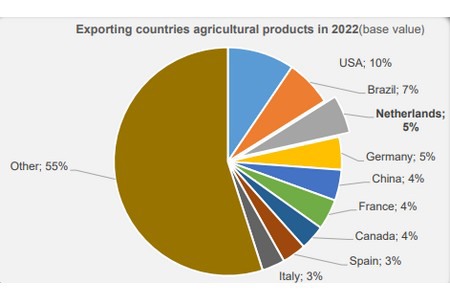
The Netherlands' share in global exports is 5%, in imports 4%
The Netherlands had a share of 5.4% of global exports' value in 2022. It should be noted that there is a lot of international trade in raw materials, which can lead to double counting, and the Netherlands also re-exports quite a lot. The WUR also looks at the import and export of agriculture-related products, such as agricultural machinery and greenhouse materials. That amounts to €5 billion in imports and €10 billion in exports. Also, the WUR uses CBS figures for the Netherlands, which, unlike Eurostat figures, exclude so-called quasi-transit: the import and subsequent export of goods that remain the property of an overseas company.
Dairy, horticultural products, and meat top the Netherlands' exports
In 2023, the Netherlands' major export products were dairy/eggs, horticulture, and meat, each with a value of around €12 billion. In fourth place are beverages (excl. fruit juices) with €9 billion. Then, both at €9 billion and including frozen products, fruits/nuts, and vegetables and potatoes.
Prepared fruit and vegetables, incl. fruit juices (€7.5 billion), natural fats and oils (€7.5 billion), grain, milk, and flour preparations (€7 billion), animal feed (€6.8 billion), cocoa and its preparations (€6.2 billion), and fish (€5.1 billion) follow. In short, a wide range of products. Volume-wise, animal feed is the most important, with dairy, potatoes/vegetables, beverages, and natural fats/oils following.
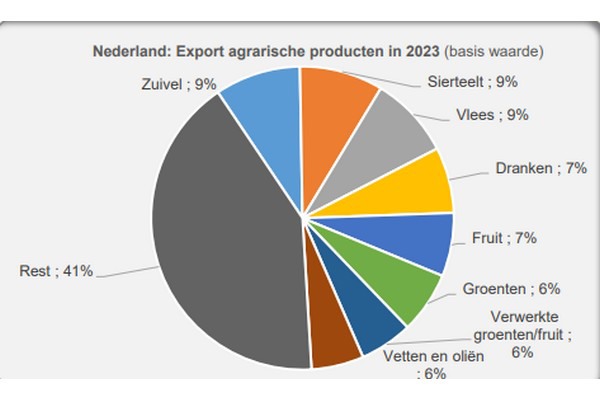
Fruit, the most important Dutch import
The Netherlands' agricultural product imports involve a considerable number of products, too. The largest are fruits/nuts with €9.4 billion, followed by natural fats and oils (€8.4 billion), beverages (€6.7 billion), meat (€5.9 billion), dairy (€5.8 billion), and oil-bearing fruits and seeds (€5.3 billion). Then there is animal feed (€4.3 billion), fish (also €4.3 billion), grains (€4 billion), prepared fruit and vegetables (€3.7 billion), potatoes and greens (incl. frozen) at €3.4 billion, and horticultural products with an import value of €2.6 billion.
As with exports, a wide range of other product groups follow. In terms of volume, beverages are the largest, followed closely by grains, and then animal feed, oil-bearing seeds/fruits, and natural fats/oils. There are generally plenty of raw materials being traded alongside finished products.
Globally, grains are the most important product
If it is strictly about food products (excluding things like horticultural and tobacco products, wood, and natural rubber), the Netherlands exported products worth €117 billion and imported €85 billion in 2023. These are Eurostat figures. On a global scale, you can source figures from TradeMap/ITC. It has complete statistics available for 2022. According to this source, food products worth €2 trillion were traded worldwide that year. For the Netherlands, it shows food product exports of €104 billion. That represents a share of 5.4%.
Thus, the Netherlands occupies third place, after the United States with €182 billion and Brazil with €127 billion. Both those countries primarily export oil-bearing seeds, grains, and meat. China is the top recipient of those agricultural export powerhouses. Other significant food product exporting countries are Germany (€89 billion), China (€84 billion), France (€83 billion), Canada (€68 billion), Spain (€66 billion), Italy (€62 billion), Belgium (€52 billion), Indonesia (€51 billion), and India (€48 billion).
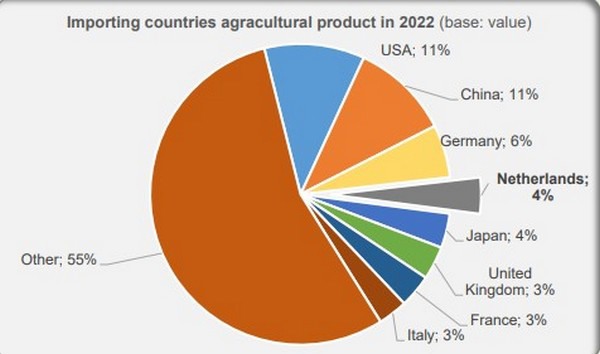
Globally, grains are the most significant export product, with a combined value of €172 billion. Then come natural oils and fats with €168 billion, meat (€158 billion), oil-bearing seeds and fruits (€146 billion), beverages, excl. fruit juices (€142 billion), fish (€140 billion), fruits/nuts, incl. frozen (€134 billion), dairy (€109 billion), and animal feed (€104 billion).
The US, the top importing country, too
In global imports, just like exports, according to TM/ITC, the United States led the way in 2022 with a value of €216 billion, with China following closely with €212 billion. Then comes Germany with €113 billion and the Netherlands with an import value of €77 billion. That is a share of just under four percent.
The Netherlands is a tiny fruit and vegetable production player
When it comes to worldwide fruit and vegetable production, the Netherlands is, with tenths of a percent share, a very modest player. It is more important for international trade. In terms of quantity, the Netherlands has over 10% of the share in global fresh vegetable trading. The same goes for fresh fruit imports. It is worth noting that less than seven percent of the country's total fruit and vegetable production is traded internationally as fresh produce.
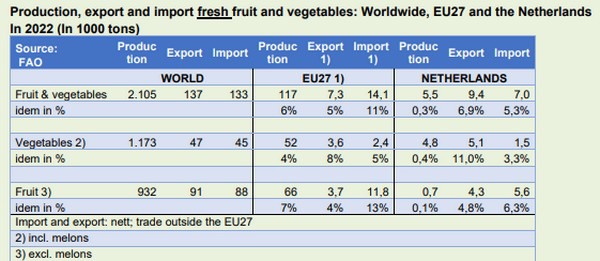
Click here for the background figures.
For more information:
Jan Kees Boon
Fruit and Vegetable Facts
www.fruitandvegetablefacts.com
[email protected]










